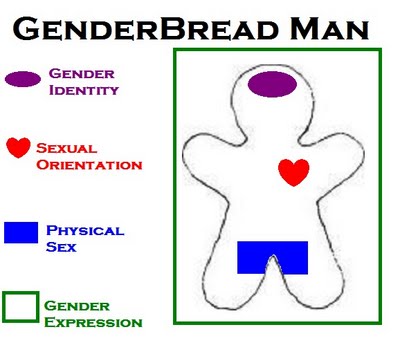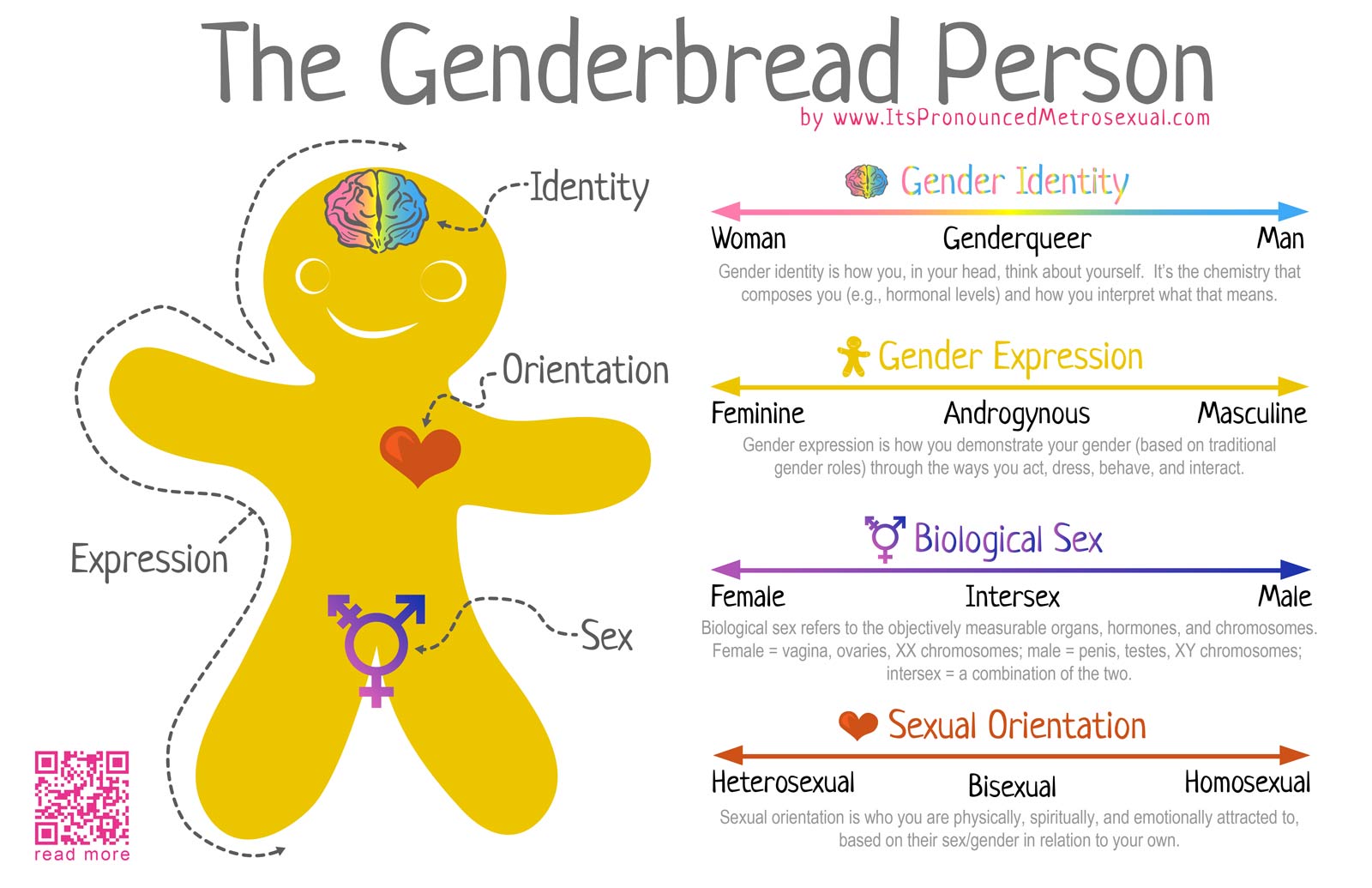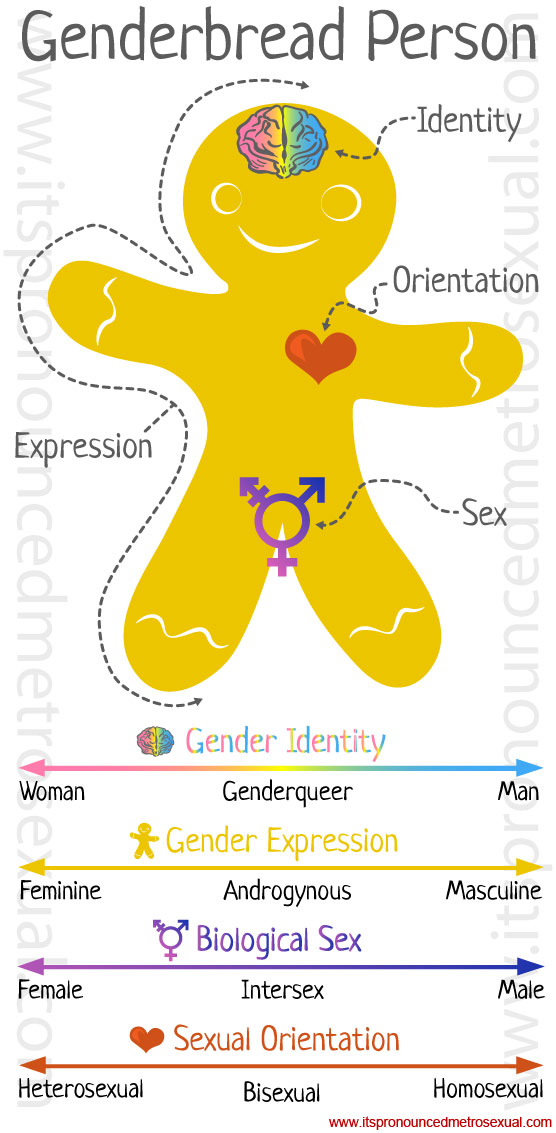Gender is a tough subject to tackle. There are a lot of facets to consider, a lot of pressures at play, and we have all been conditioned in such a way that our first instinct is almost unanimously wrong. But we’re going to tackle it. No, we’re going to tackle the snot out of it. Coming to our aid, I would like to present to you: The Genderbread Person!

I was first introduced to the Genderbread Person through Tumblr, a fun, and sometimes informative, microblogging platform. Then I saw another version (pictured right) somewhere else on the web. There are also a few other versions floating around, but they all have their issues. I wanted to create a new and improved Genderbread Person, so I did.
Now let’s talk about it.
The Genderbread Person
As you’ll see above, we have four elements. I will break those down, but first I want to talk in generalities. First of all, if you noticed that the first three categories all pertain to gender, while the fourth pertains to sexuality, great job. Skip ahead to the next paragraph. For everyone else: if that doesn’t make sense to you, or you’re unsure of how all four interrelate, worry not. By the end of this post it’ll all make sense or you can have your money back. And if you never gave me money, give me money.
Whenever I talk to groups about gender, a common problem arises: people tend to assume that someone has to be on either the left half or the right half of all the continuums above, and when I explain that many people zig zag through the list, they give me blank stares. I’m about to say something that will likely freak you out, but be cool, because it’ll all make sense soon. Gender identity, gender expression, biological sex, and sexual orientation are independent of one another (i.e., they are not connected). With that said (I’m going to say it again later), let’s move on.
Gender Identity: Who You Think You Are
On the left we have “woman” and on the right we have “man,” two terms you are likely already familiar with. In the middle, we have the term “genderqueer,” which, you guessed it, is used for an identity that is somewhere between woman and man. Another term for genderqueer that is accepted within the community is “genderfuck,” but that’s a bit racy for my taste. It’s also important to note that many people consider their identity to fall outside of the traditional (and limited) woman to man spectrum. These identities can be called genderqueer, agender, third-gender, bigender, and more.
Gender identity is all about how you, in your head, think about yourself. It’s about how you internally interpret the chemistry that composes you (e.g., hormone levels). As you know it, do you think you fit better into the societal role of “woman,” or “man,” or do neither ring particularly true for you? That is, are you somewhere in-between the two? Or do you consider your gender to fall outside of the spectrum completely? The answer is your gender identity.
It has been accepted that we form our gender identities around the age of three, and after that age it is incredibly difficult to change them. Formation of identity is affected by hormones and environment just as much as it is by biological sex. Oftentimes, problems arise when someone is assigned a gender based on their sex at birth that doesn’t align with how they come to identify. We’ll talk about that more later.
Gender Expression: How You Demonstrate Who You Are
On the left we have “feminine” and on the right we have “masculine,” the two expressive terms related to “woman” and “man.” In the middle, we have a new term “androgynous,” which describes an ambiguous or mixed form of expressing gender.
Gender expression is all about how you demonstrate your gender through the ways you act, dress, behave, and interact–whether that is intentional or unintended. Gender expression is interpreted by others perceiving your gender based on traditional gender roles (e.g., men wear pants, women wear dresses). Gender expression is something that often changes from day to day, outfit to outfit, event or setting to event or setting. It’s about how the way you express yourself aligns or doesn’t with traditional ways of gendered expression. And like gender identity, there is a lot of room for flexibility here. It is likely that you slide around on this continuum throughout the week without even thinking about it. How about an example?
You wake up and you’re wearing baggy grey sweatpants and a tshirt. As you walk into your kitchen to prepare breakfast, you’re expressing an adrogynous-to-slightly-masculine gender. However, you see your partner in the kitchen and you prowl in like Halle Berry from Catwoman, then you are expressing much more femininely, so now you’re back on the left half of the continuum. You pour a bowl of cereal, wrap your fist around a spoon like a viking, and start shoveling Fruit Loops into your face, and all-of-a-sudden you’re sliding back onto the right side of the continuum. After breakfast, you skip back into your bedroom and playfully place varying outfits in front of you, pleading your partner help you decide what to wear. You’re feminine again.
I assume this entire time you were imagining it was you, with your gender identity, acting out that example. Now go through the whole thing, but imagine someone with the a different gender identity from you going through the motions. Now you are starting to understand how these concepts interrelate, but don’t interconnect.
Biological Sex: The Equipment Under the Hood
On the left we have “female” and on the right we have “male,” the two biological sexes we all grew up knowing about. In the middle, we have a new term “intersex,” which describes someone whose sexual organs are not strictly male or female. The term “hermaphrodite,” which you’ve likely heard used to describe an intersex individual, is frowned upon as “hermaphrodite” is a stigmatizing word that means someone who is entirely male and female, a biological impossibility. P.S. How did you feel about me expressing my masculinity in the heading of this section?
Biological sex refers to the objectively measurable organs, hormones, and chromosomes you possess. Being female means having a vagina, ovaries, two X chromosomes, predominant estrogen, and you can grow a baby in your stomach area. Being male means having testes, a penis, an XY chromosome configuration, predominant testosterone, and you can put a baby in a female’s stomach area. Being intersex can be any combination of what I just described.
For example, someone can be born with the appearance of being male (penis, scrotum, etc.), but have a functional female reproductive system inside. There are many examples of how intersex can present itself, and below you can see some statistics from the Intersex Society of North America that describe the frequency of intersex births. (check out the stat I bolded, but be prepared to be shocked)
| Condition | Frequency |
|---|---|
| Not XX and not XY | one in 1,666 births |
| Klinefelter (XXY) | one in 1,000 births |
| Androgen insensitivity syndrome | one in 13,000 births |
| Partial androgen insensitivity syndrome | one in 130,000 births |
| Classical congenital adrenal hyperplasia | one in 13,000 births |
| Late onset adrenal hyperplasia | one in 66 individuals |
| Vaginal agenesis | one in 6,000 births |
| Ovotestes | one in 83,000 births |
| Idiopathic (no discernable medical cause) | one in 110,000 births |
| Iatrogenic (caused by medical treatment, for instance progestin administered to pregnant mother) | no estimate |
| 5 alpha reductase deficiency | no estimate |
| Mixed gonadal dysgenesis | no estimate |
| Complete gonadal dysgenesis | one in 150,000 births |
| Hypospadias (urethral opening in perineum or along penile shaft) | one in 2,000 births |
| Hypospadias (urethral opening between corona and tip of glans penis) | one in 770 births |
| Total number of people whose bodies differ from standard male or female | one in 100 births |
| Total number of people receiving surgery to “normalize” genital appearance | one or two in 1,000 births |
Sexual Orientation: Who You Are Attracted To
On the left we have “heterosexual,” meaning attracted to people of the opposite sex, or being straight. On the right we have “homosexual,” meaning attracted to people of the same sex, or being gay or lesbian. And in the middle we have bisexual, meaning attracted to people of both sexes. Note: there is no place on the scale for “asexual”, which is the lack of sexual attraction to others, as it doesn’t fit into this continuum.
Sexual orientation is all about who you are physically, spiritually, and emotionally attracted to. If you are male and you’re attracted to females, you’re straight. If you’re a male who is attracted to males and females, you’re bisexual. And if you’re a male who is attracted to males, you’re gay. This is the one most of us know the most about. We hear the most about it, it’s salient in our lives, and we understand where we stand best. It’s pretty cut and dry, right? Maybe.
Interestingly enough, pioneering research conducted by Dr. Alfred Kinsey in the mid-20th century uncovered that most people aren’t absolutely straight or gay/lesbian. Instead of just asking “do you like dudes or chicks?” (very sciency, I know), he asked people to report their fantasies, dreams, thoughts, emotional investments in others, and frequency of sexual contact. Based on his findings, he broke sexuality down into a seven point scale (see below), and reported that most people who identify as straight are actually somewhere between 1 – 3 on the scale, and most people who identify as lesbian/gay are 3-5, meaning most of us are a little bi-.
0 – Exclusively Heterosexual
1 – Predominantly heterosexual, incidentally homosexual
2 – Predominantly heterosexual, but more than incidentally homosexual
3 – Equally heterosexual and homosexual
4 – Predominantly homosexual, but more than incidentally heterosexual
5 – Predominantly homosexual, incidentally heterosexual
6 – Exclusively Homosexual
Putting it all together.
Wow, that was a lot of information all at once, can we agree? The crazy part: I held back. I plan to write individual write-ups on each of the sections above, because there is still so much to say. But you don’t need to worry about that right now. We need to make this all make sense–synthesize some knowledge up in your brain.
Interrelation versus Interconnection
Remember earlier when I said that thing, then I said I would say it again? It’s on the right, in case you forgot. This me saying that again: though the four things I presented above are certainly interrelated, they are not interconnected. What do I mean by that?
Gender identity, gender expression, biological sex, and sexual orientation are independent of one another (i.e., they are not connected).People’s sexual orientation doesn’t determine their gender expression. And their gender expression isn’t determined by their gender identity. And their gender identity isn’t determined by their biological sex. And also every other mismatch of A isn’t determined by B combination you can dream up from those inputs. Those things certainly affect one another (i.e., they are related to one another) but they do not determine one another.
If someone is born with male reproductive organs and genitalia, he is very likely to be raised as a boy, identify as a man, and express himself masculinely. We call this identity “cisgender” (when your biological sex aligns with how you identify) and it grants a lot of privilege (read some of them in this list of cisgender privileges). It’s something most of us who have it don’t appreciate nearly as much as we should.
Questions, Concerns, or Thoughts?
Take some time to mull all of this over, particularly if it’s the first time you’re learning about this super-complex, super-hard-to-swallow subject. There’s a lot of information to process, and most of it goes against a lot of what you might have been learned growin’ up.
Also, feel free to use the comments on this post to discuss, ask questions, or provide different insights to what you read above. Heck! That’s what they’re there for!
And as always, get in touch if you have any questions you’d rather not ask in an open forum. I’m always willing to help, if I can.
Heads up: A ton (ton) of people have written me over the years asking what the origin of the genderbread/gumby model is. I really wish I knew, but I don’t. It existed before Google 🙂 But if you know, let me know.







